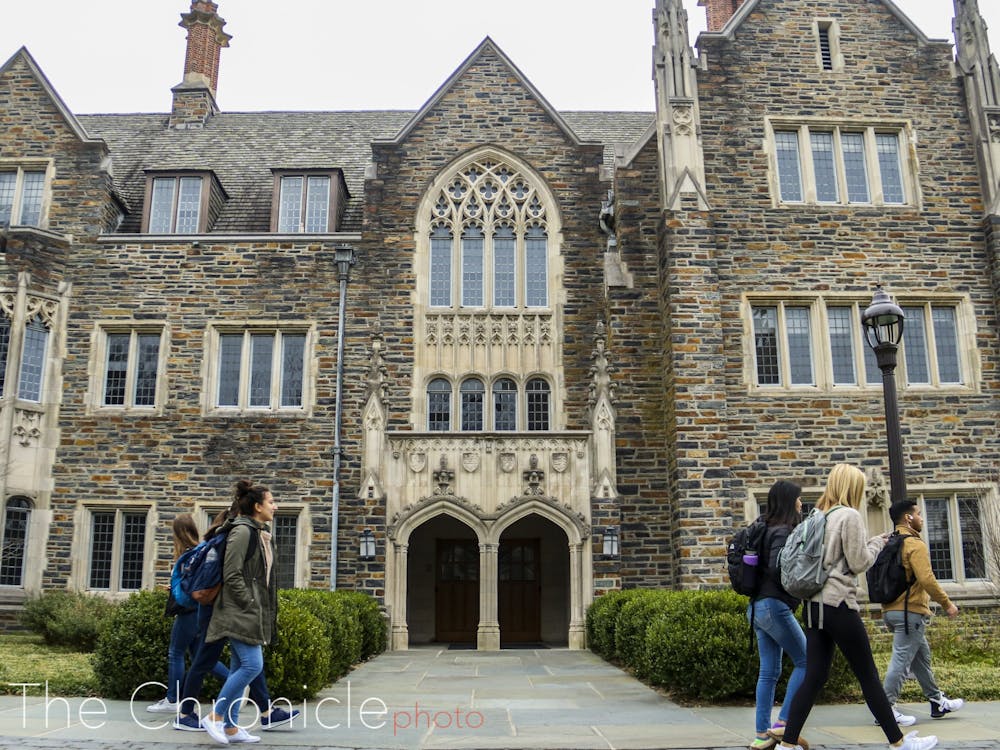As Duke faces the challenges of the ongoing coronavirus pandemic, two task forces of administrators and academic leaders are guiding the planning process.
President Vincent Price appointed two task forces in April to guide short- and long-term planning amid the challenges posed by the COVID-19 pandemic. Team 2021 is focused on campus operations in the near future, with an emphasis on the upcoming academic year, while Team 2030 is focused on longer-term planning for the financial challenges of the pandemic.
Executive Vice Provost Jennifer Francis and Vice President for Administration Kyle Cavanaugh co-chair the 2021 task force. Provost Sally Kornbluth is chair of the 2030 task force. The other members are drawn from across the University, with several vice presidents sitting on Team 2021 and the deans of all 10 Duke schools on Team 2030, according to a list of the members provided by Michael Schoenfeld, vice president for public affairs and government relations.
There are no students directly included on the task forces. Cavanaugh wrote in an email that Team 2021 will seek student input as they move into specific planning with consequences for students, on issues from housing assignments to “compliance with new behavioral expectations such as masking and social distancing.”
Kornbluth wrote in an email that Team 2030 will solicit ideas from students and give them the opportunity to “comment on some of the ideas going forward.”
Team 2021
Cavanaugh emphasized that although Team 2021 will advise Price and his team on decisions about the next academic year, they won’t make the decisions themselves. Instead, the task force is “coordinating and synthesizing recommendations” from different working groups.
The team is keeping in contact with deans, faculty governance committees and leaders in undergraduate departments as well as the Nicholas School of the Environment and the Sanford School of Public Policy.
Francis is working with faculty, academic leaders and others to develop “a range of options” for the fall, Cavanaugh wrote, and those options are being updated as the team gets new information. Schoenfeld told The Chronicle last week that students will be returning to campus, but plans including the number of students to return and the calendar will be announced by the end of June.
Along with Francis and Cavanaugh, top administrators and representatives from across the University round out the task force’s membership. The roster includes six other Duke vice presidents:
- Tim Walsh, vice president for finance and University treasurer
- Tracy Futhey, vice president for information technology and chief information officer
- Mary Pat McMahon, vice provost and vice president for student affairs
- Kevin White, vice president and director of athletics
- Michael Schoenfeld, vice president for public affairs and government relations
- Pamela Bernard, vice president and general counsel
Scott Gibson, executive vice dean for administration for the School of Medicine, and Gary Bennett, vice provost for undergraduate education, are the final two members.
Bennett is currently working with a team to incorporate undergraduate input, Cavanaugh wrote, while Francis is working with a team that includes faculty and senior leaders appointed by the deans of Duke’s graduate schools.
Planning around the next academic year goes beyond the the task force. Although he is not a member, Edward Balleisen, vice provost for interdisciplinary studies, is working with a team to find summer job opportunities for students, according to Cavanaugh.
Another group is grappling with issues affecting international students. Specific groups are also looking into technology, medical and health recommendations and research lab reopenings, according to Cavanaugh.
“At this point there are hundreds of colleagues working on numerous issues across Duke,” Cavanaugh wrote.
Team 2030
Team 2030’s membership includes the deans of the University’s 10 schools, who are the “chief academic leaders and are the core of the task force,” Kornbluth wrote in an email. Schoenfeld is also on the task force, as well as four additional members:
- Executive Vice President Tallman Trask
- Chancellor for Health Affairs A. Eugene Washington
- Academic Council Chair Kerry Haynie
- Peter Feaver, professor of political science and public policy
Kornbluth wrote that Feaver is leading a group of former chairs of the Academic Programs Committee and University Priorities Committee to ensure there is faculty input.
She wrote that the task force aims to “maintain Duke’s excellence in education and research,” considering ideas into the next decade. In the shorter term, from 2020 to 2023, the group is focusing on how to maintain that excellence while containing costs, she wrote.
“As for every other institution, COVID-19 will impact Duke’s finances and we will have to both be innovative and make choices about priorities,” Kornbluth wrote.
She wrote that she thinks there will be “great enthusiasm” for recommendations by the task force that “elevate Duke’s mission and prominence.”
Correction: An earlier version of this article incorrectly referred to the "Academic Planning Committee." The correct name is "Academic Programs Committee." The Chronicle regrets the error.
Get The Chronicle straight to your inbox
Signup for our weekly newsletter. Cancel at any time.

Mona Tong is a Trinity senior and director of diversity, equity and inclusion analytics for The Chronicle's 117th volume. She was previously news editor for Volume 116.

